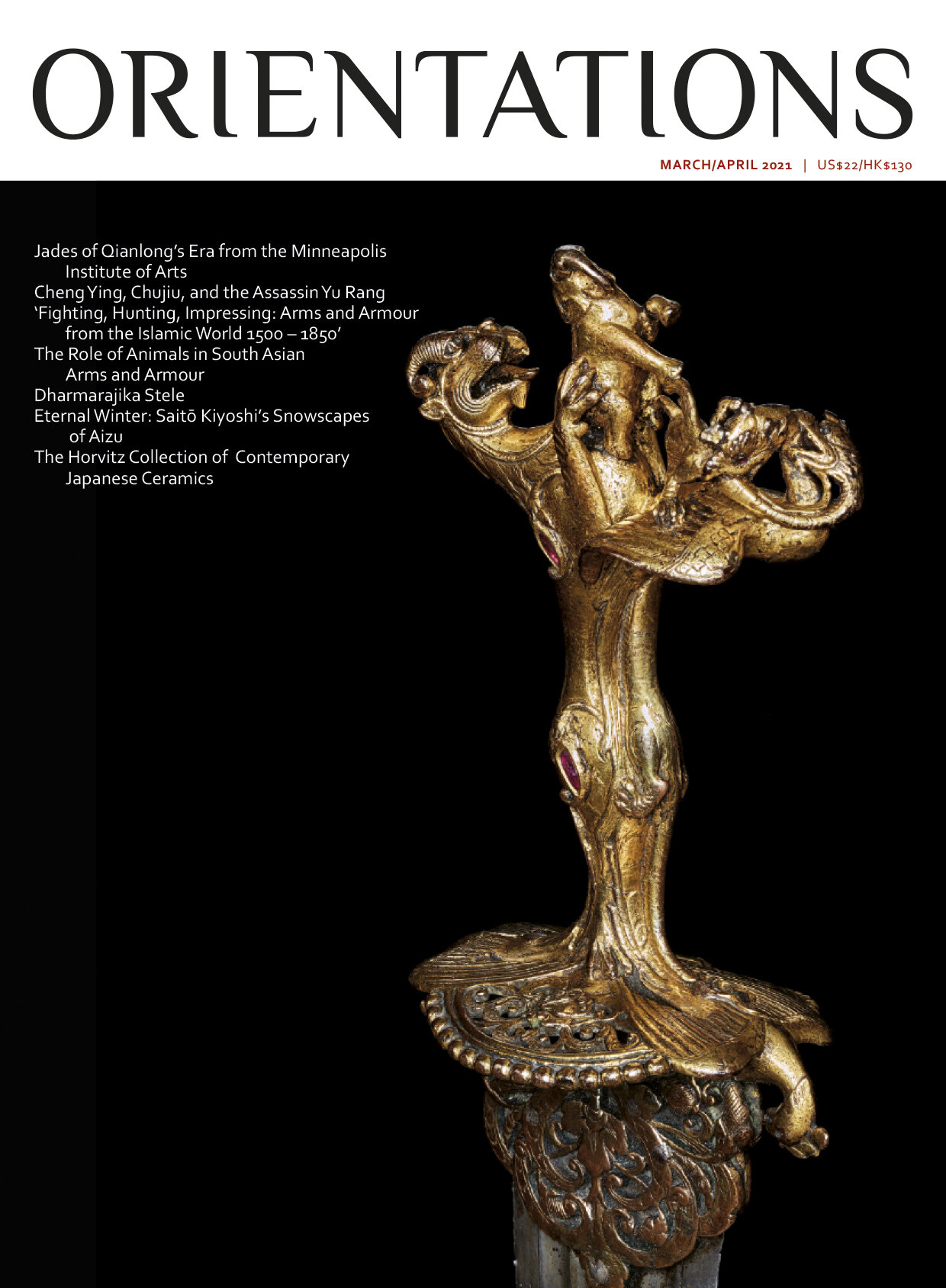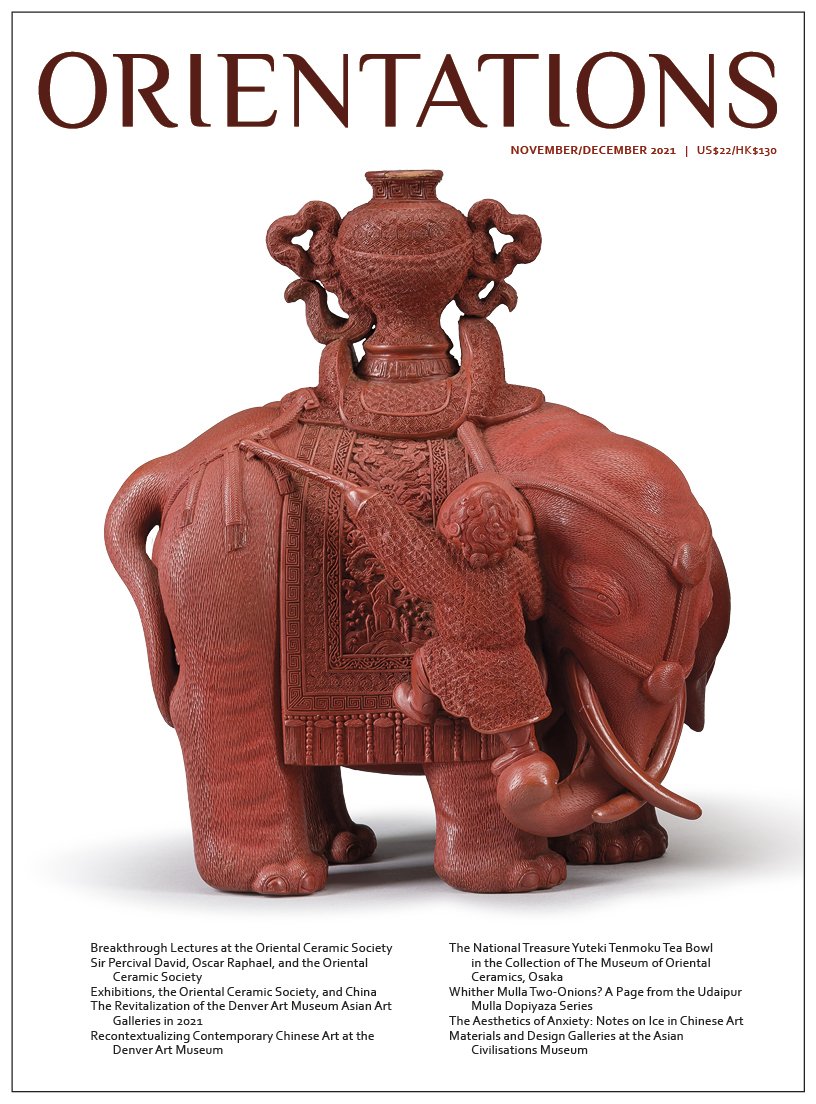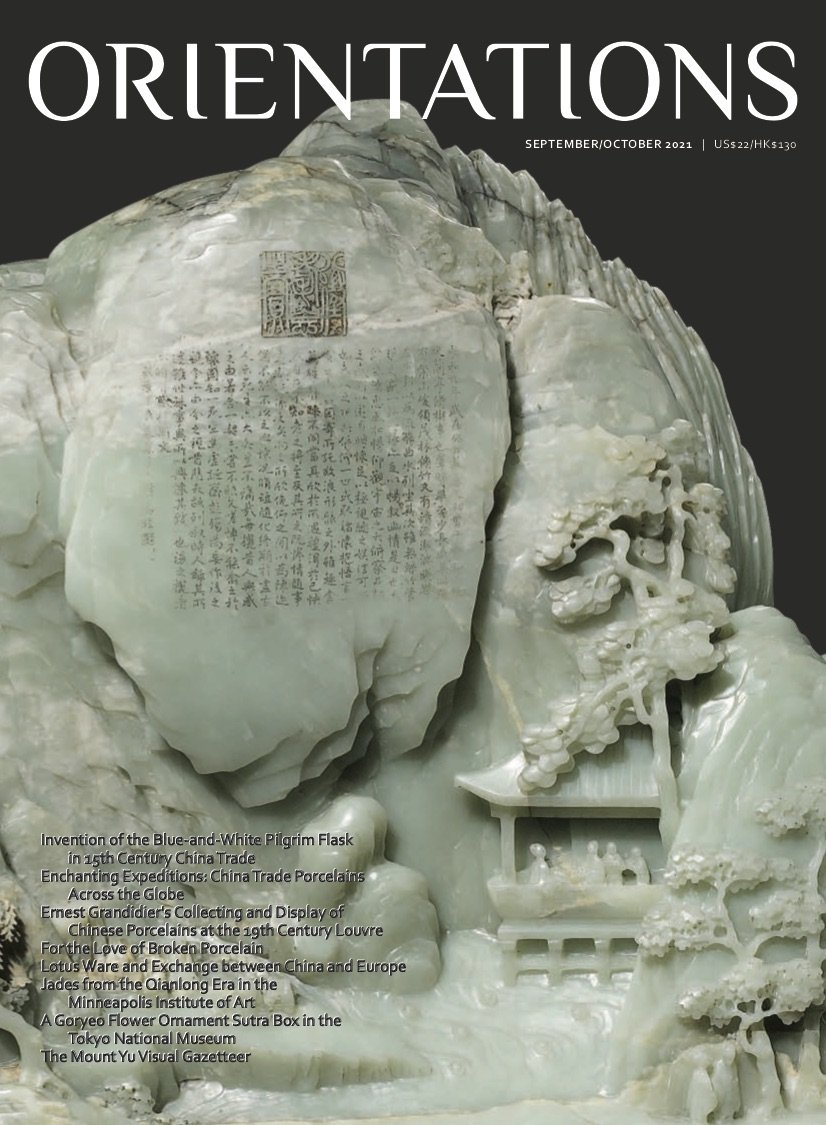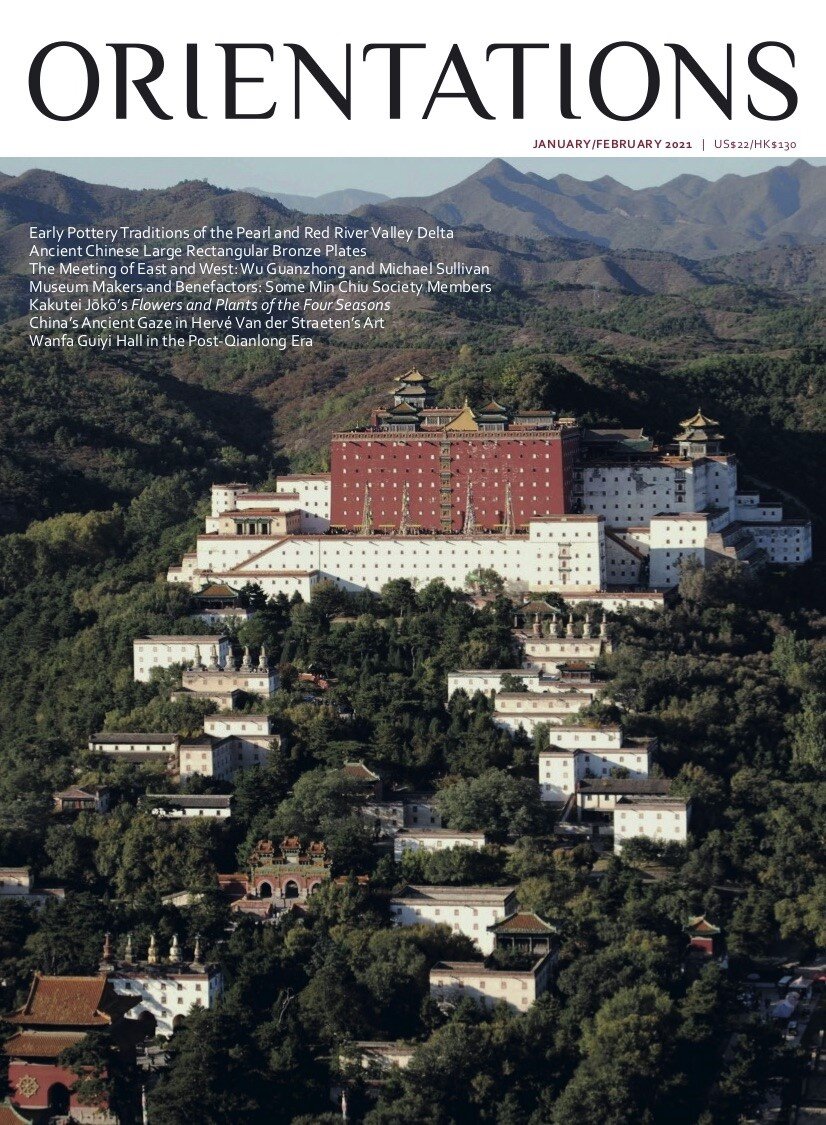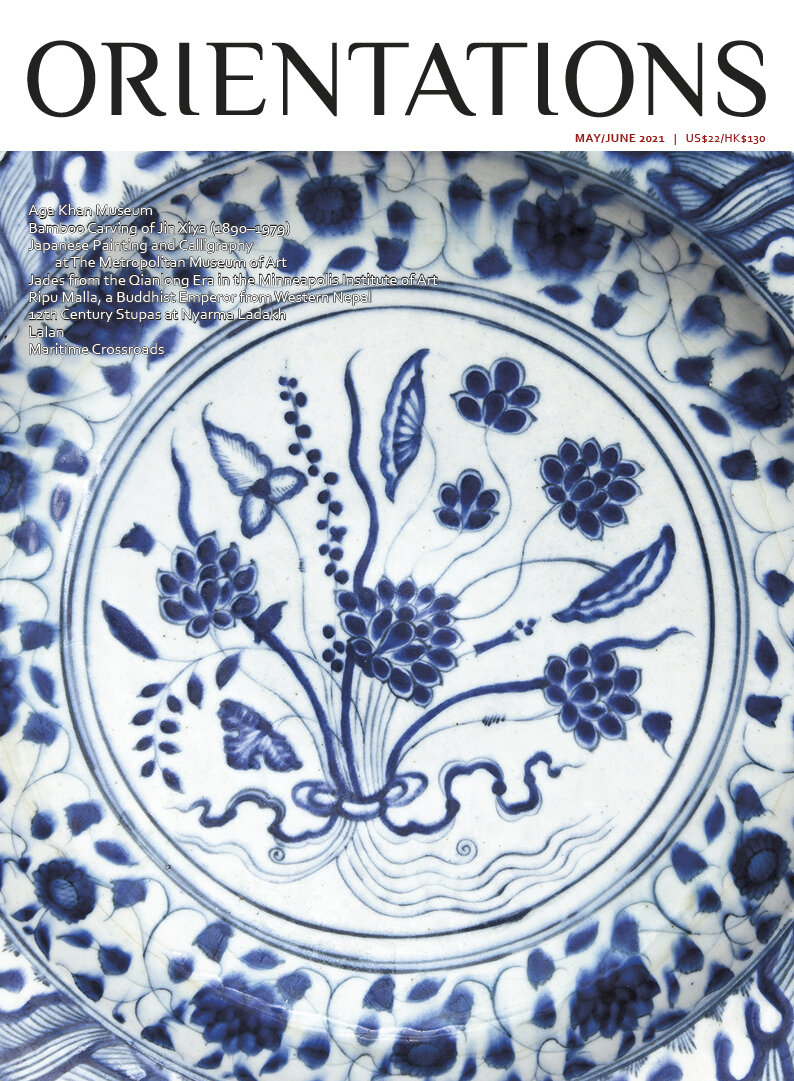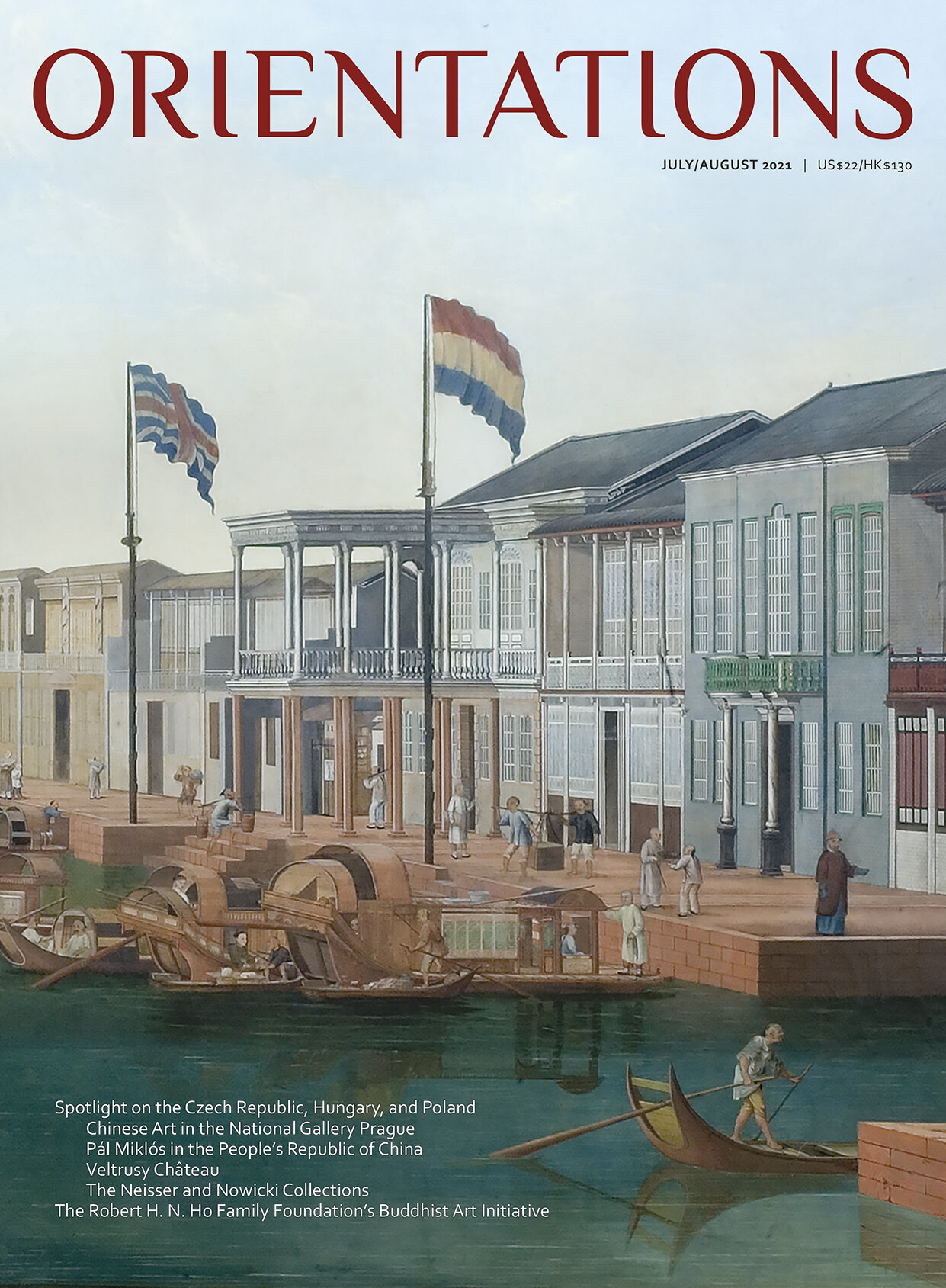MAR/APR 2021
VOLUME 52 - NUMBER 2
I travelled to Scandinavia for the first time in the spring of 2018. One of the highlights of the trip was learning of and visiting the David Collection in Copenhagen. Behind an unassuming door of a neoclassical building that overlooks the Rosenborg Castle Gardens is one of the finest collections of Islamic art in Europe. In an interview, the director of the David Collection, Kjeld von Folsach, shares how the decision was made to expand the Islamic collection when this was not the collecting focus of the museum’s founder, Christian Ludvig David (1878–1960). A new special exhibition, ‘Fighting, Hunting, Impressing: Arms and Armour from the Islamic World, 1500–1850’, is due to open on 26 March, featuring objects that were all lent from the National Museum of Denmark, the David Collection, and private collections within Denmark.
We frequently revisit the Qianlong period (1735– 96) in this magazine, as his reign was one marked by stability, prosperity, and the flourishing of arts and culture in China. Qianlong was a great patron of jade carvings, and thus important jade production centres were established in Beijing, Suzhou, and Yangzhou. In the first article of a three-part series on jades from the Qianlong era, we focus on the emperor’s appreciation of carvings with a picturesque quality, which he called ‘mood of painting’.
A previously unpublished painting from the Edo period (1603–1868) by an anonymous artist tells the legend of Cheng Ying, Chujiu, and the assassin Yu Rang from China’s Spring and Autumn period (722–481 BCE). This tale of two loyal retainers who saved the orphaned son of their murdered lord so that he can one day avenge his father’s death and retake power is unfamiliar to many art historians as it is infrequently represented in paintings.
More than 100 prints by Saitō Kiyoshi (1907–97) have been donated to the Ringling Museum of Art by Robyn and Charles Citrin. Saitō was a central figure in the modernist Creative Prints movement, whose artists carved and printed their own designs, thereby claiming complete authorship of their works. While Saito experimented with abstraction, his best-known body of work is the ‘Winter in Aizu’ series, which draws upon themes of landscapes and rural customs and subjects from his hometown. In March, the museum will open a major exhibition of the works, titled ‘Saitō Kiyoshi: Graphic Awakening’.
Japanese ceramics were heavily influenced by Chinese and Korean traditions and also by Western aesthetics after the second half of the 19th century. We interview Carol and Jeffrey Horvitz, who systematically acquired the largest private collection of museum-quality Japanese modern and contemporary ceramics outside of Japan. The collection ranges from pieces that echo traditional works to those that display modern sensibilities.
I wrote in my January/February 2020 memo that a broader and more inclusive definition of the term museum was adopted by the International Council of Museums in 2019. However, a friend pointed out that the proposal actually was not adopted but rather tabled until 2022. This decision was timely, as the new definition can include lessons learned from the challenges brought about by the COVID-19 pandemic.
This issue welcomes the Chinese new year of the metal ox, a zodiac sign that symbolizes hard work, strength, and stability: traits to strive towards as we emerge from the extraordinary circumstances of the past year.
FEATURES
Liu Yang. In Pursuit of the Picturesque Jades from the Qianlong Era in the Minneapolis Institute of Art
Matthew McKelway. Cheng Ying, Chujiu, and the Assassin Yu Rang. Ancient Chinese Revenge in Early Modern Japanese Painting
Joachim Meyer. Fighting, Hunting, Impressing: Arms and Armour from the Islamic World, 1500-1850
Rachel Parikh. Might and Menagerie: The Role of Animals in South Asian Arms and Armour
Gerald Kozicz and Heinrich Poell. The Dharmarajika Stele Revisited
Rhiannon Paget. Eternal Winter: Saitō Kiyoshi's Snowscapes of Aizu. Flowers and Plants of the Four Seasons
Jason Steuber. Fired in the Past for the Present Future. The Horvitz Collection of Contemporary Japanese Ceramics
Anne Duchange. Object of the Month: Investigating an Imperial Screen in a Copenhagen Museum
PREVIEWS & REVIEWS
Sylvia Lu Fraser. Burmese Silver Art: Masterpieces Illuminating Buddhist, Hindu and Mythological Stories of Purpose and Wisdom by David C. Owens
INTERVIEWS
An Interview with Kjeld von Folsach, Director of The David Collection
TRIBUTES
Dr John Clarke (1954-2020)
Dr Michael Wai Mai LAU (1930-2020)
CURATOR’S CHOICE
Xu Xiaodong. Two Rare Canton Painted Enamel Wares for the Islamic Market
VOLUME 52 - NUMBER 2
I travelled to Scandinavia for the first time in the spring of 2018. One of the highlights of the trip was learning of and visiting the David Collection in Copenhagen. Behind an unassuming door of a neoclassical building that overlooks the Rosenborg Castle Gardens is one of the finest collections of Islamic art in Europe. In an interview, the director of the David Collection, Kjeld von Folsach, shares how the decision was made to expand the Islamic collection when this was not the collecting focus of the museum’s founder, Christian Ludvig David (1878–1960). A new special exhibition, ‘Fighting, Hunting, Impressing: Arms and Armour from the Islamic World, 1500–1850’, is due to open on 26 March, featuring objects that were all lent from the National Museum of Denmark, the David Collection, and private collections within Denmark.
We frequently revisit the Qianlong period (1735– 96) in this magazine, as his reign was one marked by stability, prosperity, and the flourishing of arts and culture in China. Qianlong was a great patron of jade carvings, and thus important jade production centres were established in Beijing, Suzhou, and Yangzhou. In the first article of a three-part series on jades from the Qianlong era, we focus on the emperor’s appreciation of carvings with a picturesque quality, which he called ‘mood of painting’.
A previously unpublished painting from the Edo period (1603–1868) by an anonymous artist tells the legend of Cheng Ying, Chujiu, and the assassin Yu Rang from China’s Spring and Autumn period (722–481 BCE). This tale of two loyal retainers who saved the orphaned son of their murdered lord so that he can one day avenge his father’s death and retake power is unfamiliar to many art historians as it is infrequently represented in paintings.
More than 100 prints by Saitō Kiyoshi (1907–97) have been donated to the Ringling Museum of Art by Robyn and Charles Citrin. Saitō was a central figure in the modernist Creative Prints movement, whose artists carved and printed their own designs, thereby claiming complete authorship of their works. While Saito experimented with abstraction, his best-known body of work is the ‘Winter in Aizu’ series, which draws upon themes of landscapes and rural customs and subjects from his hometown. In March, the museum will open a major exhibition of the works, titled ‘Saitō Kiyoshi: Graphic Awakening’.
Japanese ceramics were heavily influenced by Chinese and Korean traditions and also by Western aesthetics after the second half of the 19th century. We interview Carol and Jeffrey Horvitz, who systematically acquired the largest private collection of museum-quality Japanese modern and contemporary ceramics outside of Japan. The collection ranges from pieces that echo traditional works to those that display modern sensibilities.
I wrote in my January/February 2020 memo that a broader and more inclusive definition of the term museum was adopted by the International Council of Museums in 2019. However, a friend pointed out that the proposal actually was not adopted but rather tabled until 2022. This decision was timely, as the new definition can include lessons learned from the challenges brought about by the COVID-19 pandemic.
This issue welcomes the Chinese new year of the metal ox, a zodiac sign that symbolizes hard work, strength, and stability: traits to strive towards as we emerge from the extraordinary circumstances of the past year.
FEATURES
Liu Yang. In Pursuit of the Picturesque Jades from the Qianlong Era in the Minneapolis Institute of Art
Matthew McKelway. Cheng Ying, Chujiu, and the Assassin Yu Rang. Ancient Chinese Revenge in Early Modern Japanese Painting
Joachim Meyer. Fighting, Hunting, Impressing: Arms and Armour from the Islamic World, 1500-1850
Rachel Parikh. Might and Menagerie: The Role of Animals in South Asian Arms and Armour
Gerald Kozicz and Heinrich Poell. The Dharmarajika Stele Revisited
Rhiannon Paget. Eternal Winter: Saitō Kiyoshi's Snowscapes of Aizu. Flowers and Plants of the Four Seasons
Jason Steuber. Fired in the Past for the Present Future. The Horvitz Collection of Contemporary Japanese Ceramics
Anne Duchange. Object of the Month: Investigating an Imperial Screen in a Copenhagen Museum
PREVIEWS & REVIEWS
Sylvia Lu Fraser. Burmese Silver Art: Masterpieces Illuminating Buddhist, Hindu and Mythological Stories of Purpose and Wisdom by David C. Owens
INTERVIEWS
An Interview with Kjeld von Folsach, Director of The David Collection
TRIBUTES
Dr John Clarke (1954-2020)
Dr Michael Wai Mai LAU (1930-2020)
CURATOR’S CHOICE
Xu Xiaodong. Two Rare Canton Painted Enamel Wares for the Islamic Market
VOLUME 52 - NUMBER 2
I travelled to Scandinavia for the first time in the spring of 2018. One of the highlights of the trip was learning of and visiting the David Collection in Copenhagen. Behind an unassuming door of a neoclassical building that overlooks the Rosenborg Castle Gardens is one of the finest collections of Islamic art in Europe. In an interview, the director of the David Collection, Kjeld von Folsach, shares how the decision was made to expand the Islamic collection when this was not the collecting focus of the museum’s founder, Christian Ludvig David (1878–1960). A new special exhibition, ‘Fighting, Hunting, Impressing: Arms and Armour from the Islamic World, 1500–1850’, is due to open on 26 March, featuring objects that were all lent from the National Museum of Denmark, the David Collection, and private collections within Denmark.
We frequently revisit the Qianlong period (1735– 96) in this magazine, as his reign was one marked by stability, prosperity, and the flourishing of arts and culture in China. Qianlong was a great patron of jade carvings, and thus important jade production centres were established in Beijing, Suzhou, and Yangzhou. In the first article of a three-part series on jades from the Qianlong era, we focus on the emperor’s appreciation of carvings with a picturesque quality, which he called ‘mood of painting’.
A previously unpublished painting from the Edo period (1603–1868) by an anonymous artist tells the legend of Cheng Ying, Chujiu, and the assassin Yu Rang from China’s Spring and Autumn period (722–481 BCE). This tale of two loyal retainers who saved the orphaned son of their murdered lord so that he can one day avenge his father’s death and retake power is unfamiliar to many art historians as it is infrequently represented in paintings.
More than 100 prints by Saitō Kiyoshi (1907–97) have been donated to the Ringling Museum of Art by Robyn and Charles Citrin. Saitō was a central figure in the modernist Creative Prints movement, whose artists carved and printed their own designs, thereby claiming complete authorship of their works. While Saito experimented with abstraction, his best-known body of work is the ‘Winter in Aizu’ series, which draws upon themes of landscapes and rural customs and subjects from his hometown. In March, the museum will open a major exhibition of the works, titled ‘Saitō Kiyoshi: Graphic Awakening’.
Japanese ceramics were heavily influenced by Chinese and Korean traditions and also by Western aesthetics after the second half of the 19th century. We interview Carol and Jeffrey Horvitz, who systematically acquired the largest private collection of museum-quality Japanese modern and contemporary ceramics outside of Japan. The collection ranges from pieces that echo traditional works to those that display modern sensibilities.
I wrote in my January/February 2020 memo that a broader and more inclusive definition of the term museum was adopted by the International Council of Museums in 2019. However, a friend pointed out that the proposal actually was not adopted but rather tabled until 2022. This decision was timely, as the new definition can include lessons learned from the challenges brought about by the COVID-19 pandemic.
This issue welcomes the Chinese new year of the metal ox, a zodiac sign that symbolizes hard work, strength, and stability: traits to strive towards as we emerge from the extraordinary circumstances of the past year.
FEATURES
Liu Yang. In Pursuit of the Picturesque Jades from the Qianlong Era in the Minneapolis Institute of Art
Matthew McKelway. Cheng Ying, Chujiu, and the Assassin Yu Rang. Ancient Chinese Revenge in Early Modern Japanese Painting
Joachim Meyer. Fighting, Hunting, Impressing: Arms and Armour from the Islamic World, 1500-1850
Rachel Parikh. Might and Menagerie: The Role of Animals in South Asian Arms and Armour
Gerald Kozicz and Heinrich Poell. The Dharmarajika Stele Revisited
Rhiannon Paget. Eternal Winter: Saitō Kiyoshi's Snowscapes of Aizu. Flowers and Plants of the Four Seasons
Jason Steuber. Fired in the Past for the Present Future. The Horvitz Collection of Contemporary Japanese Ceramics
Anne Duchange. Object of the Month: Investigating an Imperial Screen in a Copenhagen Museum
PREVIEWS & REVIEWS
Sylvia Lu Fraser. Burmese Silver Art: Masterpieces Illuminating Buddhist, Hindu and Mythological Stories of Purpose and Wisdom by David C. Owens
INTERVIEWS
An Interview with Kjeld von Folsach, Director of The David Collection
TRIBUTES
Dr John Clarke (1954-2020)
Dr Michael Wai Mai LAU (1930-2020)
CURATOR’S CHOICE
Xu Xiaodong. Two Rare Canton Painted Enamel Wares for the Islamic Market

